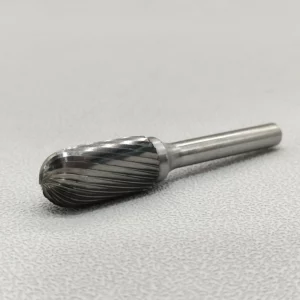Carbide rotary burrs are indispensable tools in various industries, prized for their versatility and efficiency in shaping, grinding, and carving tasks. In this article, we will delve into what carbide rotary burrs are, how they work, and their significance in modern manufacturing processes.
Carbide rotary burrs, often referred to simply as burrs, are cutting tools used for shaping, grinding, and carving hard materials such as metals, wood, plastic, and composites. They consist of a tungsten carbide cutting head attached to a rotary tool, such as a die grinder or a flexible shaft machine. The cutting head of a carbide rotary burr is typically shaped like a cylinder, ball, cone, or tapered cylinder, with multiple flutes or blades that facilitate material removal.
One of the key advantages of carbide rotary burrs is their exceptional hardness and durability, owing to the use of tungsten carbide as the cutting material. Tungsten carbide is a composite material composed of tungsten and carbon atoms, renowned for its hardness and resistance to wear and abrasion. This hardness allows carbide rotary burrs to maintain sharp cutting edges even when used on tough materials, resulting in efficient material removal and extended tool life.
The operation of carbide rotary burrs relies on the rotational motion of the tool and the abrasive action of the cutting head. When the rotary tool is activated, the cutting head spins at high speeds, making contact with the workpiece. As the cutting head rotates, the sharp edges of the flutes or blades bite into the material, gradually removing material through a combination of grinding and cutting action.
The effectiveness of carbide rotary burrs in material removal can be attributed to several factors. Firstly, the hardness of the tungsten carbide cutting head enables it to withstand the high forces and temperatures generated during the cutting process without dulling or deforming significantly. Additionally, the sharp cutting edges of the burr ensure precise and efficient material removal, allowing for intricate shaping and detailing tasks.
Carbide rotary burrs are commonly used in various industries, including metalworking, woodworking, engineering, automotive, aerospace, and dentistry. In metalworking applications, carbide rotary burrs are utilized for deburring, shaping, grinding, and porting operations on materials such as steel, aluminum, brass, and cast iron. Woodworkers employ carbide burrs for shaping and carving tasks, achieving intricate designs and smooth finishes with ease.
The versatility of carbide rotary burrs extends to their compatibility with different rotary tools and mounting options. They can be used with handheld die grinders, pneumatic rotary tools, electric drills, and CNC machines, providing flexibility in application across various work environments. Additionally, carbide burrs are available in a wide range of shapes, sizes, and flute configurations to suit specific cutting requirements and material types.
Proper maintenance and handling are essential to maximize the performance and longevity of carbide rotary burrs. After each use, it is recommended to clean the burr to remove any debris or residue that may accumulate on the cutting edges. Additionally, periodic inspection of the burr for signs of wear or damage is crucial, as worn or damaged burrs may result in poor cutting performance or safety hazards.
In conclusion, carbide rotary burrs are versatile and efficient cutting tools widely used in various industries for shaping, grinding, and carving tasks. Their exceptional hardness, durability, and sharp cutting edges make them indispensable for precision material removal applications. Understanding the functionality of carbide rotary burrs is essential for maximizing their performance and ensuring quality results in manufacturing processes.
In summary, carbide rotary burrs are indispensable tools in various industries, prized for their versatility and efficiency in shaping, grinding, and carving tasks. Their exceptional hardness and durability, coupled with sharp cutting edges, make them ideal for precision material removal applications. Understanding how carbide rotary burrs work is crucial for maximizing their performance and achieving quality results in manufacturing processes.
